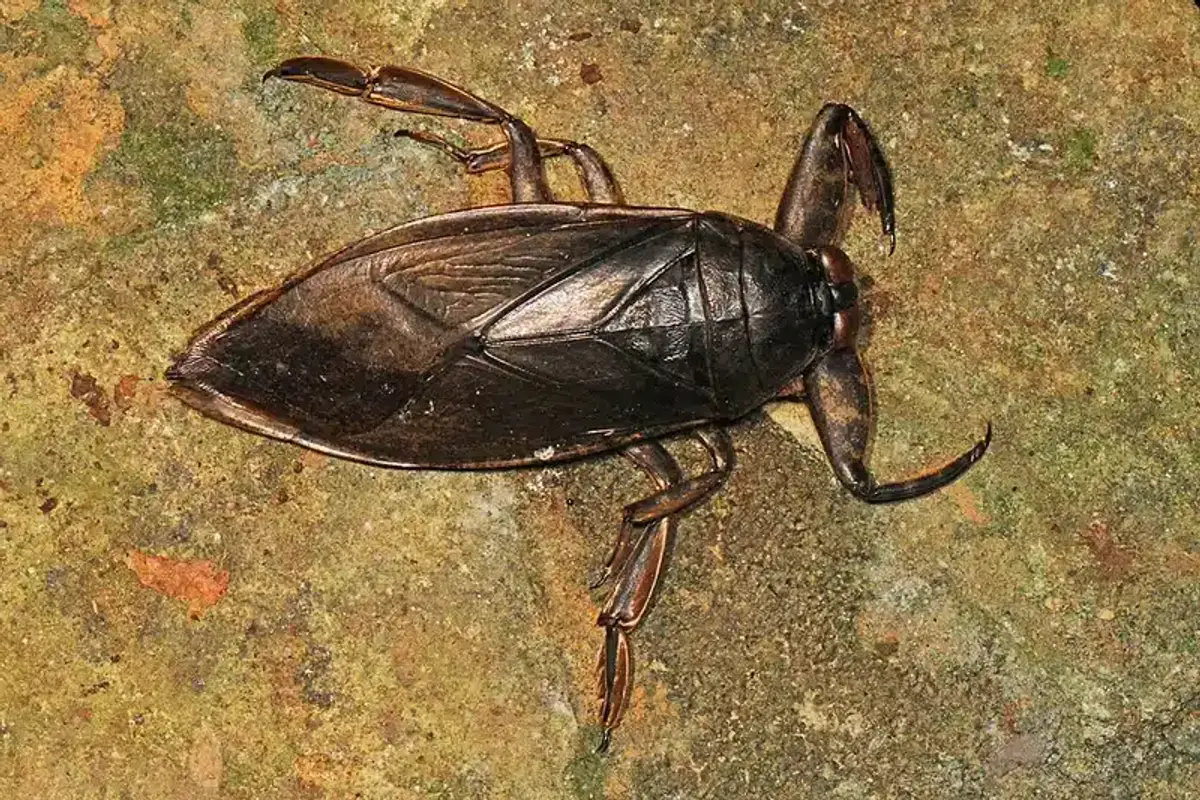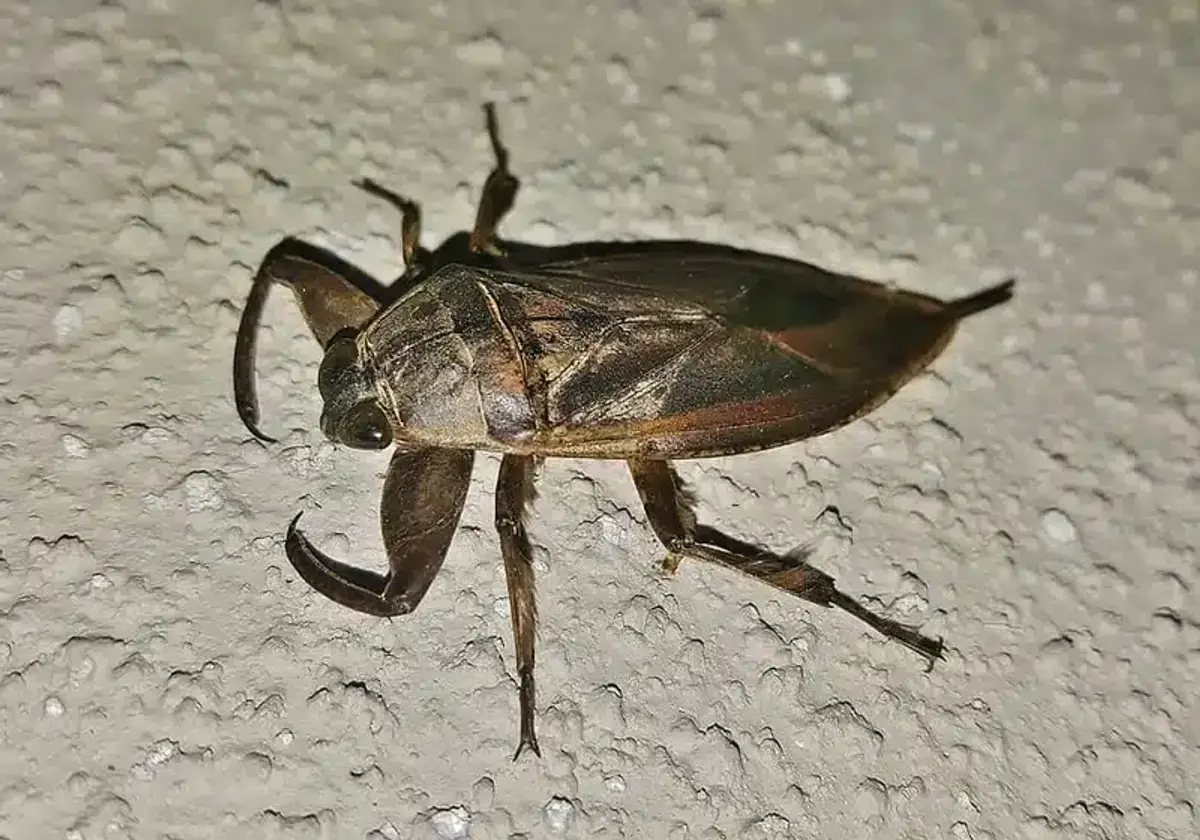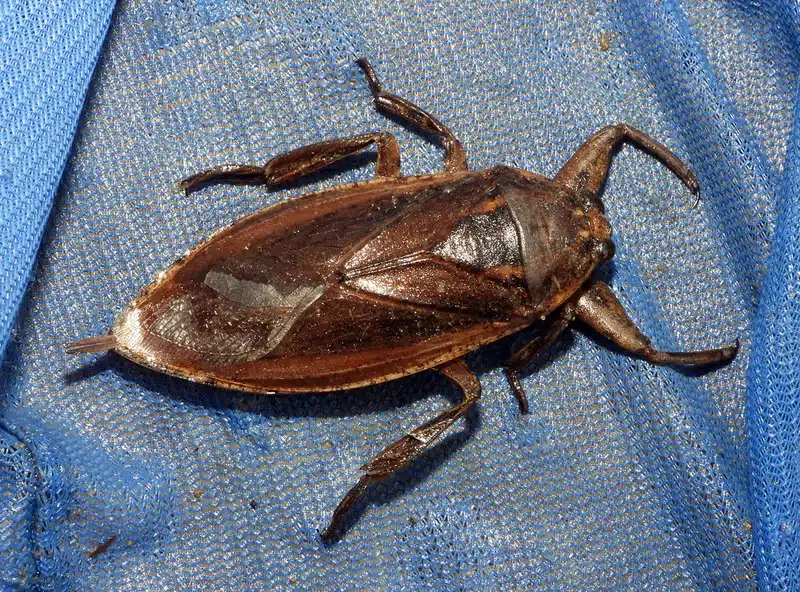Finding water bugs in your home can be alarming. Many homeowners aren’t sure what they’re dealing with or how to get rid of them. After spending four years as a registered technician with our family business serving the DMV area for over 50 years, I’ve seen countless water bug issues. Most importantly, I’ve learned that what people call “water bugs” usually aren’t water bugs at all.
The term “water bug” gets thrown around a lot, but it actually refers to two completely different types of insects. Understanding this difference is crucial for effective treatment. Let me walk you through everything you need to know about identifying and eliminating these pests from your home.
Understanding Water Bugs: True Water Bugs vs. Cockroach “Water Bugs”
The confusion around water bugs starts with terminology. True water bugs belong to the family Belostomatidae and live in ponds, streams, and other aquatic environments. These are the giant water bugs that occasionally fly to porch lights and earn nicknames like “electric-light bugs” or “toe-biters.”
However, when homeowners in our service area mention water bugs in their basements or crawl spaces, they’re almost always talking about Oriental roaches. These cockroaches love moisture and have earned the “water bug” nickname because of their preference for damp areas.
During my years treating homes across Virginia, Maryland, and DC, I can count on one hand the times someone actually had true water bugs inside their house. The real culprits are typically Oriental or American roaches that have found their way indoors seeking moisture and shelter.
This distinction matters because the treatment approach for aquatic insects versus moisture-loving cockroaches is completely different. True water bugs don’t infest homes, while cockroaches absolutely do.
What Do Water Bugs Look Like: Complete Identification Guide
Proper identification is the first step in any successful treatment plan. Let me break down the key differences between these commonly confused insects.

Oriental cockroaches are what most people mean when they say “water bugs.” These roaches measure about 18-25 mm and have a glossy dark brown or black appearance. Male Oriental roaches have short wings that don’t cover their entire abdomen, while females appear almost wingless. Their bodies are flattened and built for running through tight spaces.
American roaches are larger, reaching up to 40 mm in length. They have a reddish-brown color with a distinctive yellowish figure-8 pattern on the back of their head. Unlike Oriental roaches, American roaches can fly and are more likely to be found throughout the entire house.
Giant water bugs look completely different from cockroaches. They have oval, flattened bodies that can reach 35-65 mm in our region. Their front legs are modified for grasping prey (called raptorial legs), and their hind legs are adapted for swimming. According to the University of Florida’s research, they also have breathing tubes that they hold at the water surface.
Water Bugs Life Cycle and Seasonality
Understanding the life cycle helps predict when and where you’ll encounter these pests. Oriental cockroaches have a relatively slow development compared to other roach species.
The female Oriental roach produces an egg case (called an ootheca) that’s about 8-10 mm long and purse-shaped. She glues this case in hidden spots like behind appliances or in wall voids. The eggs take 6-8 weeks to hatch, releasing up to 16 nymphs.
These nymphs go through 6-12 months of development before becoming adults. Adult Oriental roaches can live about a year. Population peaks typically occur in late spring through early summer, but they migrate indoors when temperatures drop or during dry spells.
Giant water bugs have a fascinating life cycle that includes paternal care—the males actually carry or guard the eggs. They go through five nymphal stages over about two months, and adults overwinter in pond or stream mud.
In the DMV area, we see the most indoor Oriental roach activity from November through February when cold weather pushes them inside. This timing helps explain why many homeowners first notice water bugs during winter months.
Water Bugs Habitat and Behavior
Oriental roaches thrive in environments with high humidity and temperatures below 84°F. This makes basements, crawl spaces, and utility rooms perfect territories for them. They’re commonly found outdoors under mulch, in leaf litter, storm drains, and sewer systems.
These roaches enter homes through surprisingly small gaps at ground level, pipe penetrations, and floor drains. During my inspections, I frequently find them in homes where excessive mulch sits against foundations or where clogged gutters create moisture problems.

True giant water bugs require standing or slow-moving water with vegetation. They’re predators that hunt tadpoles, small fish, and other aquatic creatures. Their flight activity toward lights peaks from May through September, which is when homeowners occasionally find them in pool skimmers or near outdoor lighting.
The key difference in behavior is that Oriental roaches actively seek indoor harborage, while giant water bugs only end up indoors by accident. If you’re seeing the same insects repeatedly, you’re dealing with cockroaches, not aquatic water bugs.
Health Risks and Public-Health Impact of Water Bugs
The health implications vary dramatically between true water bugs and cockroach “water bugs.” Oriental cockroaches pose significant health risks because they contaminate food surfaces and living spaces.
Health Risk Alert
These roaches carry bacteria including Salmonella, Staphylococcus, and Streptococcus on their bodies. More concerning for many families, their shed skins and feces trigger asthma and allergies, especially in children. The EPA specifically lists cockroaches as asthma triggers in schools.
Additionally, Oriental roaches leave behind allergen proteins that can persist in homes long after the infestation is eliminated. This is why thorough treatment and ongoing prevention matter so much for families with respiratory sensitivities.
Giant water bugs, on the other hand, can deliver a painful bite but don’t transmit diseases or contaminate living spaces. Their bite is defensive and only occurs when they’re handled directly. They don’t establish indoor populations or create ongoing health risks.
The bottom line is that cockroach “water bugs” create serious, ongoing health concerns while true water bugs are essentially harmless to human health.
Water Bugs Inspection and Monitoring Techniques
Effective water bug treatment starts with thorough inspection. During our 78-point home inspections, we look for specific signs that indicate active cockroach populations.
Night inspections work best because Oriental roaches are nocturnal. Using a flashlight, check around exterior foundation cracks, utility penetrations, and areas where trash containers sit. Look for live adults, shed skins, and dark brown egg cases.
Interior inspection focuses on moisture-rich areas like basements, laundry rooms, and areas around water heaters. Check behind appliances, around floor drains, and in utility closets where pipes create condensation.
Monitoring tools include:
- Sticky traps placed along baseboards in suspected areas
- Shallow jar traps baited with beer-soaked bread for outdoor populations
- Fluorescent dye tablets in floor drains to identify sewer ingress points
We recommend checking traps weekly and documenting any captures. This helps identify activity patterns and measures treatment effectiveness over time.
Professional Pest Control Methods for Getting Rid of Water Bug Infestations
Successful water bug control requires multiple approaches working together. The most effective treatments combine sanitation, exclusion, and targeted applications.
Moisture control forms the foundation of any Oriental roach program. Fix plumbing leaks immediately and add dehumidifiers to basements. Keep floor drains wet-trapped or install screens to prevent sewer ingress. Direct downspouts at least 3 feet from foundations.
Exclusion techniques include installing door sweeps and weatherstripping thresholds. Seal gaps around pipes using silicone caulk backed with steel wool. Install 0.25-inch mesh on crawl-space vents to prevent entry while maintaining ventilation.
Chemical treatments work best when applied strategically. Gel baits containing fipronil or indoxacarb are highly effective because Oriental roaches aren’t resistant to these active ingredients. Replace gel baits when they dry out.
Inorganic dusts like boric acid and diatomaceous earth provide long-lasting control when applied in thin films to wall voids and under appliances. These products work well in dry areas but need reapplication if they get wet.
Growth regulators like hydroprene prevent successful reproduction by disrupting egg development. These work especially well combined with baits for comprehensive population control.
How to Get Rid of Water Bugs: DIY vs. When to Call a Professional
Many homeowners try over-the-counter roach sprays and baits before calling professionals. While some products can provide temporary relief, most DIY treatments miss critical aspects of comprehensive control.
Health Warning
Store-bought aerosol sprays often make problems worse by scattering roaches to new areas. Additionally, broad-spectrum sprays can repel insects away from bait stations, reducing overall treatment effectiveness.
Professional treatment becomes necessary when you’re seeing 5 or more roaches per night on monitoring traps or when you find egg cases on walls. At Better Termite & Pest Control, our registered technicians focus on moisture control, exclusion, and targeted baiting rather than just spraying.
Our approach includes identifying moisture sources, sealing entry points, and applying appropriate treatments based on the specific species and severity. We provide detailed service reports so you know exactly what products we used and where.
The Better Promise means unlimited callbacks if you’re not getting results. We’ll keep coming back until the problem is solved at no additional cost. You’re not locked into contracts and can cancel anytime with 30 days notice.
Water Bugs Prevention Checklist for Homeowners
Prevention works better than treatment when it comes to water bug control. Here’s a seasonal approach that addresses the most common issues we see in DMV homes.
Spring prevention focuses on outdoor populations before they become indoor problems:
- Remove excess mulch touching foundation walls
- Clean gutters and repair any leaks
- Trim vegetation away from the house exterior
- Inspect and seal foundation cracks
Summer maintenance targets moisture control:
- Run dehumidifiers in basements and crawl spaces
- Check and repair door sweeps and window screens
- Monitor floor drains for proper water traps
- Remove standing water from planters and containers
Fall preparation prevents winter invasions:
- Seal gaps around pipe penetrations
- Install screens on crawl-space vents
- Place monitoring traps in basements and utility areas
- Schedule professional perimeter treatments
Winter monitoring maintains exclusion barriers and watches for activity:
- Check monitoring traps monthly
- Maintain proper humidity levels indoors
- Keep exclusion barriers intact
- Address any new moisture issues immediately
Case Studies: Water Bug Treatments by a Third-Generation Technician
Real-world examples illustrate how proper identification and treatment resolve water bug problems. One recent case involved a Potomac basement that flooded during heavy rains.
The homeowners found dozens of dark insects in their basement after the water receded. They assumed these were true water bugs because of the flooding. However, inspection revealed typical Oriental roaches that had been displaced from their outdoor harborage.
Treatment included moisture control with industrial dehumidifiers, sealing foundation cracks that allowed entry, and strategic gel bait placement. Follow-up visits confirmed elimination within 4 weeks with no recurrence after 6 months.
Another case involved a DC row house where residents reported large “water bugs” coming from floor drains. Fluorescent dye testing revealed sewer line ingress through deteriorated connections.
We installed drain screens, sealed penetration points, and applied targeted dust treatments in utility areas. Combined with improved moisture control, this approach eliminated the problem and prevented reinfection from the municipal sewer system.
Conclusion
Water bugs in your home are almost certainly Oriental or American cockroaches, not true aquatic insects. These moisture-loving roaches pose real health risks and require comprehensive treatment that addresses sanitation, exclusion, and targeted applications.
Professional treatment becomes worthwhile when DIY efforts fall short or when you’re seeing consistent activity despite your best efforts. The key is choosing a company that understands the difference between quick fixes and lasting solutions.
Better Termite & Pest Control has been solving water bug problems in the DMV area for over 50 years. Our registered technicians provide thorough inspections, targeted treatments, and ongoing support to keep your home comfortable and pest-free. Learn more about our pest control costs to understand your investment options.
Frequently Asked Questions
What attracts water bugs to my home?
+
Moisture is the primary attractant for water bugs (Oriental roaches). Leaky pipes, poor drainage, high humidity in basements, and standing water create ideal conditions. Additionally, outdoor factors like excessive mulch against foundations, clogged gutters, and dense vegetation provide harborage that leads to indoor invasions.
How can I tell if it's a true water bug or a roach?
+
Location is the biggest clue. If you found it indoors, especially in basements or bathrooms, you're dealing with a cockroach. True water bugs live in ponds and streams and rarely enter homes. Body shape also differs - cockroaches have flattened bodies built for running, while water bugs have oval bodies with specialized swimming legs.
Are water bugs dangerous to humans?
+
Oriental cockroaches (commonly called water bugs) pose health risks through bacterial contamination and allergen production. They can trigger asthma and allergies, especially in children. True water bugs can bite if handled but don't infest homes or create ongoing health concerns.
What DIY treatments are effective for Oriental cockroaches?
+
Gel baits containing modern active ingredients like fipronil work well for small populations. Focus on moisture control by fixing leaks and using dehumidifiers. Seal entry points around pipes and install door sweeps. However, avoid aerosol sprays which scatter roaches and reduce bait effectiveness.
When should I call a pest control professional?
+
Professional treatment becomes necessary when you're seeing 5 or more roaches per night on monitoring traps, finding egg cases on walls, or when DIY treatments haven't solved the problem after 4-6 weeks. Extensive moisture issues or structural entry points also warrant professional assessment and treatment.
How long does professional water bug treatment take?
+
Initial treatment typically shows results within 2-3 weeks, but complete elimination takes 4-6 weeks to break the full reproductive cycle. Professional programs include follow-up visits to ensure success and prevent reinfection. Ongoing quarterly maintenance helps prevent future problems.
Can water bugs come from sewer lines?
+
Yes, Oriental roaches commonly enter homes through sewer connections, especially in older properties with deteriorated pipes. Floor drains without proper water traps provide direct access. Professional treatments often include drain screens and targeted applications in utility areas connected to sewer systems.
Do water bugs bite humans?
+
True giant water bugs can deliver painful defensive bites if handled directly, but they don't seek out humans. Oriental cockroaches (the insects usually called water bugs) don't bite humans. Their health risks come from contamination and allergen production, not biting behavior.
With five years of hands-on experience in the pest control industry, George Schulz is a registered technician with the Virginia Pest Management Association and a proud third-generation professional in a family business that's been protecting homes for over 57 years. He manages and trains a team of service pros while also leading internal research efforts—recently spearheading a deep-dive review of thousands of documents on pest control materials to hand-pick the most kid and pet friendly, most effective solutions tailored specifically for homes in the DC metro area.
